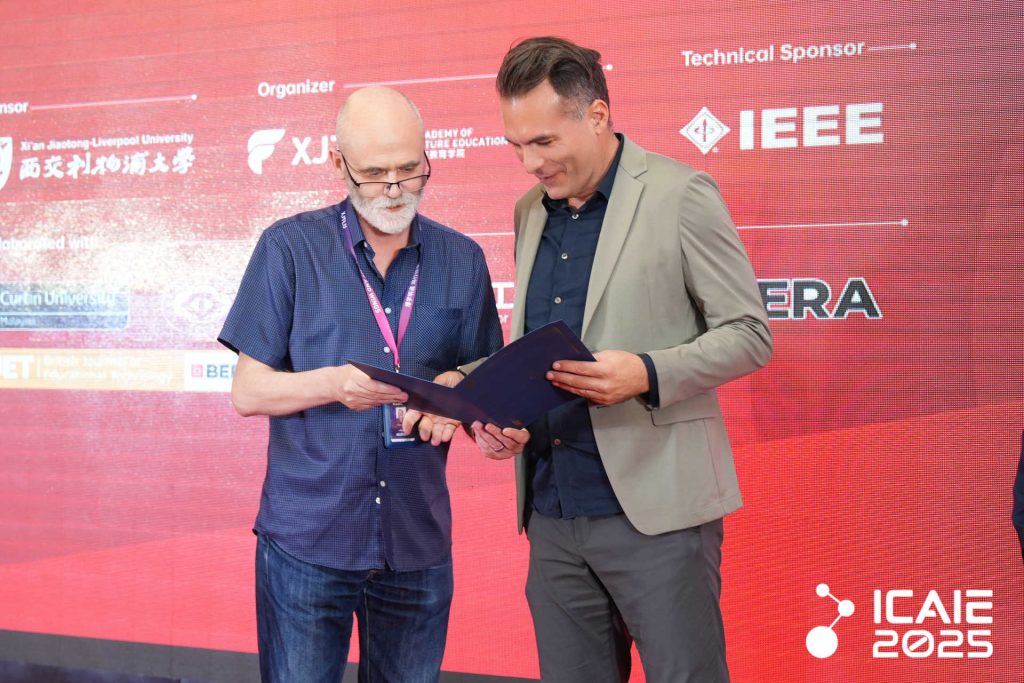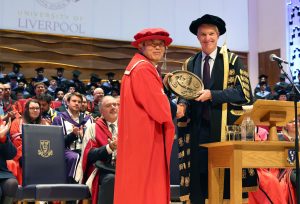06 Jun 2025
In the recent 2025 International Conference on Artificial Intelligence and Education (ICAIE) hosted by Xi’an Jiaotong-Liverpool University, Dr Juan Carlos Dall’Asta, Senior Associate Professor at XJTLU Design School’s Department of Architecture, was awarded the 2024 RC4AIED Outstanding Scientific Research Award for his ground-breaking project “AI as a Design Partner for Learning”.
This recognition highlights a research journey that, over the past six years, has redefined the creative process within architectural education through the integration of Artificial Intelligence, not as an assistant or tool, but as an intellectual presence that expands, challenges, and transforms the act of designing.

Dr Juan Carlos Dall’Asta (right)
According to Dr Dall’Asta, at the heart of his work lies a radical yet increasingly urgent question: how can emerging technologies, and AI in particular, meaningfully participate in the genesis of architectural ideas?
“While the design field has long embraced digital tools for optimisation and representation, the creative phase, where intuition, imagination, and conceptual exploration converge, has often remained protected terrain, thought to resist automation or systematisation.
“My project overturns that assumption by demonstrating how AI can become a genuine partner in design thinking, capable of sustaining a conversation, proposing unexpected directions, and enhancing the very conditions in which creativity unfolds,” he says.
AI helps expand students’ design imagination
Through hundreds of experimental case studies conducted with students in the Master in Architectural Design Programme at XJTLU, AI has been tested not as an end-user tool but as a cognitive counterpart - able to interact with human designers in dynamic, iterative, and often surprising ways. Students were encouraged to engage in dialogue with AI platforms such as Midjourney and Stable Diffusion, not for finished visualisations, but to stimulate speculation, ambiguity, and creative risk-taking.
The resulting pedagogical model reveals how AI can unlock what Dr Dall’Asta describes as an expanded design imagination. Visual and narrative suggestions generated by AI are not simply outputs to be refined; they become provocations that prompt students to rethink form, context, material, and meaning. The design process thus evolves into a conversational interplay, where intuition is augmented by algorithmic insight and where hybrid authorship becomes a shared terrain between human and machine.
By integrating AI into the creative core of the design process, the project invites a redefinition of how architecture is taught and how creativity is cultivated. It encourages students to embrace uncertainty, to see ambiguity not as a failure of clarity but as a source of potential, and to engage critically with the possibilities and limits of intelligent technologies.

Dr Dall’Asta’s approach remains firmly rooted in the principles of Human-Centred Design, yet it seeks to refresh that framework by shifting emphasis from problem-solving to problem-framing, from needs analysis to narrative invention. AI becomes a means not only to address user requirements but to reimagine them, suggesting new logics, forms, and futures that had not yet been considered. In doing so, the work bridges technical capability with cultural literacy, aligning digital experimentation with socially and environmentally attuned design practice.
“A key contributor to the success of this project has been PhD candidate Lok Hang Cheung, who has supported its development while making this research the starting point of his doctoral inquiry. His work, in dialogue with my evolving methodology, has helped solidify a framework in which AI’s presence in the studio is foundational to the emergence of new creative habits.
“The support of the Design School and Department of Architecture at XJTLU has been equally essential, who’re willing to invest in a project whose outcomes were initially uncertain demonstrates a commendable commitment to innovation in education. Their trust in the value of long-term experimentation has allowed this research to grow from isolated trials into a coherent and influential pedagogical model,” Dr Dall’Asta says.
Proposing a future for architectural education
Today, as AI continues to evolve at an astonishing speed, this research offers a blueprint for how architectural education might respond - not by retreating into traditionalism, nor by celebrating technology uncritically, but by fostering critical engagement, creative openness, and human-machine collaboration. The project positions AI not as a replacement for human ingenuity, but as a mirror, a counterpart, and a multiplier of human design potential, adds Dr Dall’Asta.
“Its impact extends beyond XJTLU. By encouraging new models of creativity, questioning established creative hierarchies, and proposing a pedagogy that is as speculative as it is rigorous, this research contributes meaningfully to contemporary debates on the role of AI in design. It speaks to educators, practitioners, and institutions seeking to navigate the uncertainties of a rapidly transforming discipline.
“It reaffirms that the future of creativity lies not in resisting change, but in shaping it through thoughtful, experimental, and human-centred innovation,” he says.
Story provided by Dr Juan Carlos Dall’Asta
Edited by Yi Qian
06 Jun 2025







